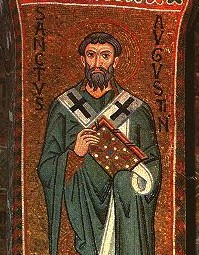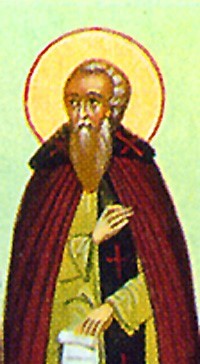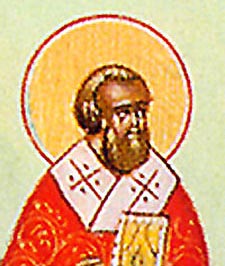The West
Saint Augustine

The Western Church was dominated intellectually and spiritually by the towering figure of Saint Augustine, Bishop of Hippo (r. 386–430), near Carthage in western North Africa. Living in a kind of communal monasticism with friends on his estate, Augustine wrote massively in Latin. His City of God was the most extensive Christian reflection on human history and its ultimate destiny ever written up to that point. His Scriptural commentaries and his many letters have provided practical guidance for many generations of Western Christians. And his remarkably intimate Confessions became a model for many more such introspective spiritual analyses.
Many of his writings were taken up with fighting three virulent heresies—Donatism, the rigorist sect of western North Africa similar to Novatianism; Manicheanism, a strictly dualist movement from Asia Minor; and Pelagianism, promoted by a British monk named Pelagius, who asserted that man could be saved by his own virtue, without the assistance of divine grace. In the heat of the polemics with these heterodox movements, Augustine did not always avoid the temptation of taking his position to the opposite extreme.
This happened most conspicuously in his anti-Pelagian writings, in which he said that man, due to the grievous calamity of Adam’s Fall, so far from being able to save himself, cannot even do anything good. Because his free will has become totally depraved due to this “original sin” of Adam, man cannot participate in his own salvation, so God must do everything.
These presuppositions led with inexorable logic to what would become known as the doctrine of double predestination. As stated many years later in the Westminster Confession (1646) of the Presbyterian Church, “By the decree of God, for the manifestation of His glory, some men and angels are predestinated unto everlasting life, and others foreordained to everlasting death.” Such a view is in stark contrast to the Orthodox understanding of synergism, in which God and man—whose free will, though damaged, was not totally corrupted at the Fall—cooperate together in the work of salvation, which God longingly desires for every human being (cf. 1 Tim 2.4).
Another problematic side to Augustine, from the Orthodox point of view, is his philosophical speculation about the Holy Trinity, in which he suggests that the Holy Spirit is the love that binds the Father and the Son. Such speculation creates some of the philosophical underpinning for the filioque, which appeared in Spain in the next century.
In addition, his claim that marital relations can never occur without the sin of concupiscence darkened in the West the traditional understanding of the full goodness of human sexuality and marriage (as seen at the Council of Nicea). This skepticism/pessimism regarding sexuality is reflected in the mandatory clerical celibacy practiced in the Roman Catholic Church to this day.
Saint John Cassian
In southern France, Saint John Cassian (c. 360–c. 435) established two monasteries based on the pattern of the Egyptian monasticism of the Desert Fathers and Mothers, with whom he had spent much time earlier in his life. In his most highly acclaimed works, The Conferences and The Institutes, he conveys the wisdom he learned from the monastics of Egypt, including their understanding of the mystery of synergism.
Saint John Cassian writing on synergism

And therefore it is laid down by all the catholic fathers who have taught perfection of heart not by empty disputes of words, but in deed and act, that the first stage in the Divine gift is for each man to be inflamed with the desire for everything that is good, but in such a way that the choice of free will is open to either side. The second stage in Divine grace is for the aforesaid practices of virtue to be able to be performed, but in such a way that the possibilities of the will are not destroyed. The third stage also belongs to the gifts of God, so that it may be held by the persistence of the goodness already acquired, and in such a way that the liberty may not be surrendered and experience bondage. For the God of all must be held to work in all, so as to incite, protect, and strengthen, but not to take away the freedom of the will which He Himself has once given.
If, however, any more subtle further human argumentation and reasoning seems opposed to this interpretation, it should be avoided, rather than brought forward to the destruction of the faith (for we do not gain faith from understanding, but understanding from faith, as it is written, “Except ye believe, ye will not understand” [Is 7.9]). For how God works all things in us and yet everything can be ascribed to free will, cannot be fully grasped by the mind and reason of man.
(The Conferences, XIII.18)
Many monasteries, sketes, and hermitages based on the Egyptian model sprang up and flourished in the mountains and valleys of eastern and southern France in the 5th and 6th centuries. The lives of nearly thirty saints in this setting were compiled near the end of the 6th century by Saint Gregory of Tours.
Pope Saint Leo the Great

In 452 Pope Saint Leo proved to be a skillful diplomat as he convinced Attila the Hun not to sack the city of Rome. Thereafter, the imperial government in Rome continued to weaken, until it was taken over by Germanic invaders from the north in 476. This marked the end of close political connections between East and West. Though political unity was restored temporarily under Emperor Justinian I in the next century, the political, cultural, and linguistic disunity that prevailed after his death was a major factor in the eventual schism in the 11th century between the Roman, Latin-speaking Church in the West and the Greek-speaking Patriarchates of the East.
Pope Leo also played a major role in the ongoing story of the gradual extension of Papal power in Western Europe. In 444 he deprived the archbishop of the city of Arles in France, who was then Metropolitan Saint Hilary of Arles, of his status as a metropolitan, thus consolidating Roman authority over this part of France. He also obtained from the Western Emperor Valentinian III a decree granting the Roman Church supreme authority over the Churches in all of Western Europe. However, it would take many more centuries of overcoming strong opposition in virtually every part of Western Europe before Rome could fully put this edict into effect.
